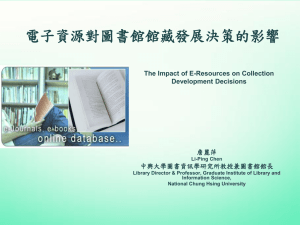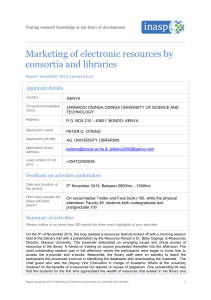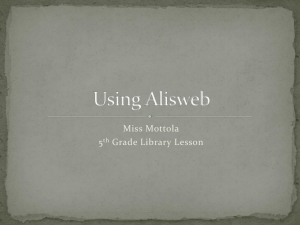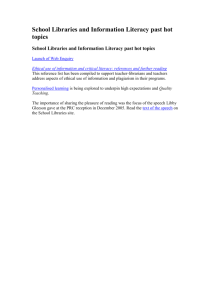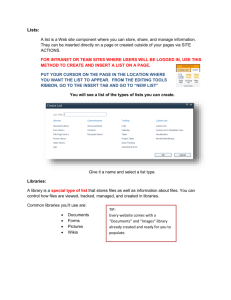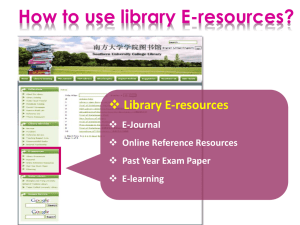Usage Statistics for Collection Assessment and Decision Making
advertisement
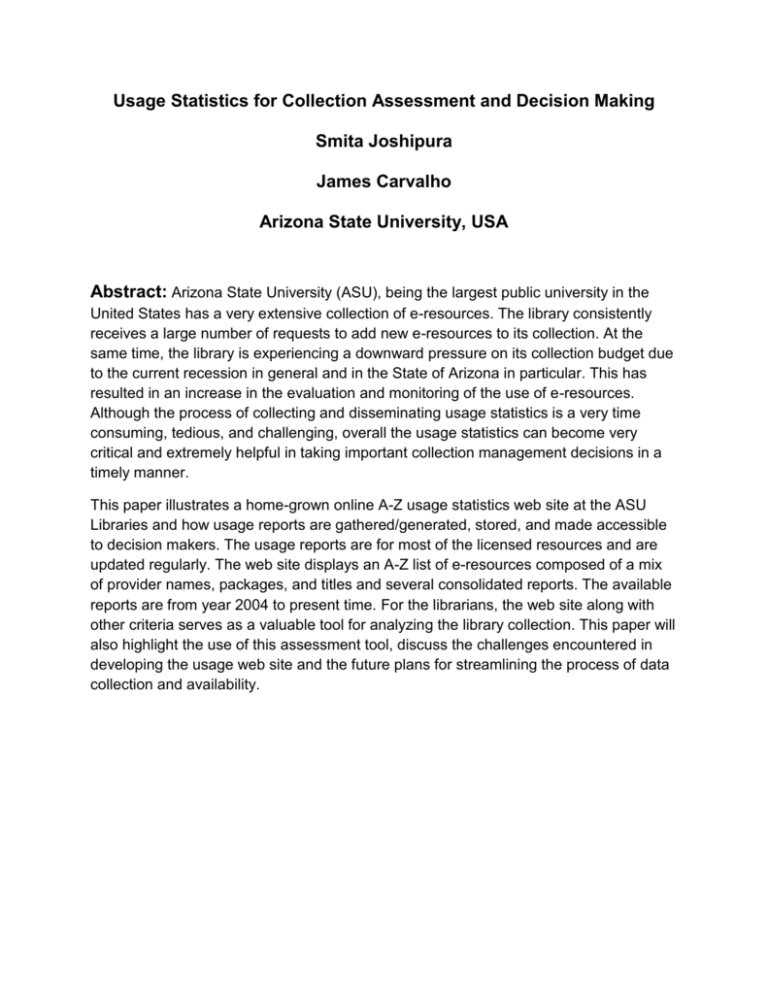
Usage Statistics for Collection Assessment and Decision Making Smita Joshipura James Carvalho Arizona State University, USA Abstract: Arizona State University (ASU), being the largest public university in the United States has a very extensive collection of e-resources. The library consistently receives a large number of requests to add new e-resources to its collection. At the same time, the library is experiencing a downward pressure on its collection budget due to the current recession in general and in the State of Arizona in particular. This has resulted in an increase in the evaluation and monitoring of the use of e-resources. Although the process of collecting and disseminating usage statistics is a very time consuming, tedious, and challenging, overall the usage statistics can become very critical and extremely helpful in taking important collection management decisions in a timely manner. This paper illustrates a home-grown online A-Z usage statistics web site at the ASU Libraries and how usage reports are gathered/generated, stored, and made accessible to decision makers. The usage reports are for most of the licensed resources and are updated regularly. The web site displays an A-Z list of e-resources composed of a mix of provider names, packages, and titles and several consolidated reports. The available reports are from year 2004 to present time. For the librarians, the web site along with other criteria serves as a valuable tool for analyzing the library collection. This paper will also highlight the use of this assessment tool, discuss the challenges encountered in developing the usage web site and the future plans for streamlining the process of data collection and availability. Introduction Due to proliferation of electronic resources (e-resources) and user preferences for the electronic format, libraries of all sizes and types have embraced e-resources as essential mainstays of library collection. As more and more e-resources are added to the library collection, libraries face a challenging environment, which makes the collection and analysis of usage statistics more important than ever. The exponential growth of e-resources in the collection has resulted into steep increase in the expenditure of budget for libraries. Hence, it becomes essential for libraries to monitor usage statistics for collection development and budget justification (Wood, 2006). Usage Statistics is not a new process and has long been used by libraries to measure the extent of their services. Usage Statistics is a valuable tool in determining users need and always been proved to be crucial. The data from gate counts to re-shelving and circulation has been used regularly for assessment purposes by the management (Matthews, 2009). With the expansion of e-resources and shrinking of library budget, librarians have realized the need for different metrics. They need to know if the eresources are used effectively. They are now less inclined to add as many e-resources as possible because they are not affordable. Instead, they are leaning towards a balanced approach to satisfy the needs of the users. To better meet user needs and make every dollar count, librarians would like to do data analysis as they have traditionally applied to print collections, focusing on usage statistics, cost, and cost per use (Stemper, 2004). Usage statistics at present is a hot issue and has created a great interest among library decision makers. It is an important source of information needed to sustain user-centered service and research environments (Knight, 2001). The usage statistics helps to justify the budget well spent. As more and more library users are gathering information online, librarians must provide hard data on their usage and benefit to the institution. Usage statistics can provide libraries with a variety of helpful information such as it can inform libraries on (1) what resources are being used, (2) how many times a particular resource is used, (3) over what period of time a resource is used, and (4) which populations are using the resources (Tannery, 2002). Usage Statistics Initiatives Usage Statistics in the print environment appears simple. However, in an electronic environment, the collection of usage statistics is a very complicated and timeconsuming process. The data is much more difficult to gather, analyze, and compare than print collections (Luther 2000). Hence, standardized collection methods and reporting is very critical for libraries. There are various collaborative efforts undertaken by librarians, e-resources providers, and library system vendors to improve the quality of statistics and some of them are highlighted below. The Association of Research Libraries (ARL) initiated measures of electronic information resources (E-Metrics) Project in 2000. It is one of the many initiatives undertaken in establishing standardized and comparable statistics for e-resources. The ARL E-Metrics Project is a joint effort by selected members of the research library community to investigate various issues and problems related to collecting and using data on electronic materials and services. More details can be found at: http://www.arl.org/stats/initiatives/emetrics/index.shtml Another joint effort in the late 1990s was initiated by International Coalition of Library Consortia (ICOLC) predominantly academic libraries working toward a standard set of definitions for subscription online contents. ICOLC has developed set of “Guidelines for Statistical Measures of Usage of Web-Based Indexed, Abstracted, and Full Text Resources” a statement to address inconsistencies in how usage data was reported. This was a significant step in the right direction, though there were issues with formatting and consistency in the reports. More details can be found at: http://www.library.yale.edu/consortia/webstats.html In 2002, a U.K. based non profit organization PALS (Publisher and Libraries Solutions) formed by the Joint Information Systems Committee, the Association of Learned and Professional Society Publishers, and The Publishers Association, created Project COUNTER (Counting Online Usage of NeTworked Electronic Resources) with a mission that lead to a standardization effort into what usage to count and how to report it. The goal was for usage statistics to be consistent, credible, and comparable resources. This project was a success and considered to be a major step forward for standardizing usage data for electronic journals (e-journals) and now electronic books (e-books). http://www.projectcounter.org COUNTER has helped significantly in standardization of data, but the problem with this model is the need to gather the usage file by file from the numerous vendor sites. Furthermore, there are still some inconsistencies in reporting. Moreover, the library system vendors are now building Electronic Resources Management (ERM) modules, which include usage consolidation applications. They load vendors’ COUNTER reports into a database from which consolidated reports can be produced. With the growing number of online vendors the time spent in gathering the reports is becoming unmanageable. And to address this issue, Standardized Usage Statistics Harvesting Initiative (SUSHI) http://www.niso.org/workrooms/sushi protocol was initiated. The objective of SUSHI is to solve the problem of harvesting usage data from a growing number of providers in the form of an automated process. It has been designed for computer-to-computer interaction without human intervention. The advantage of adopting SUSHI protocol is that it will drastically reduce the time spent collecting usage data and will increase data’s quality and consistency through the use of XML. Arizona State University Libraries Arizona State University (ASU) is one of the largest public research universities in the USA with the full time enrollment of 66,000 students. A unique aspect of ASU is that it is “One University in Many Places” having a system with four different campuses -Tempe campus, Polytechnic campus, Downtown campus, and West campus. They are all located in the metropolitan Phoenix, Arizona and run by a single administration. The same concept applies to University Libraries and is also known as “One Library in Many Places”. At Tempe campus there are five branch libraries (Architecture & Environmental Design Library, Hayden Library, Law Library, Music Library, and Noble (Science & Engineering) Library). The rest of the campuses have one library each: Polytechnic campus library, Downtown Phoenix campus library, and West campus library (Fletcher Library). Currently, the ASU Libraries e-resources collection includes 500 + databases, 90,000+ E-journal titles, 300,000+E-books with the expenditure of about 78% of the Materials budget. The E-resources collection is overseen by Collections Steering Council (CSC) formed in 2006, which meets twice in a month. The CSC serves in an advisory capacity to the Office of Collections and Scholarly Communications and is a primary group for deliberations on library collection policies. Issues pertaining to collection development and management (i.e., identification, selection, processing, acquisition, assessment, and evaluation) are considered by the CSC. This council has a representation from all the four campuses. The membership includes Director/Representative from all the four campuses; Heads of Collections and Scholarly Communications Office, Informatics and Cyber Infrastructure Services, Bibliographic and Metadata Services and Subject area specialists; Collections and Scholarly Communications librarian, Acquisitions librarian, Electronic Resources Coordinator and Legal contract specialist. Usage Statistics at ASU Libraries ASU Libraries have significant size of e-resources collection and to optimize the value of e-resources, it was important to collect usage statistics. Moreover, CSC plays a very prominent role in the evaluation of e-resources and realized that an assessment tool would assist members with timely collection development decisions. Hence, in 2007, ASU Libraries began an initiative to collect usage statistics for all e-resources, including journals and online databases. This has resulted into creating an A-Z Usage Statistics web site. A-Z Usage Statistics Web Site at ASU At ASU Libraries an Electronic Resources Usage Reports web site was created to assist with collection development decision making process. The site currently has usage reports for most of the licensed packages. It is password protected and only available to the librarians. Furthermore, it is regularly updated and special requests for the latest reports on one or more packages are promptly added. The web site displays an A-Z usage reports list, which is composed of a mix of provider names, packages, and titles. It also specifies the reporting period, which typically begins from 2004. Additionally, all links to the COUNTER compliant reports are displayed with the COUNTER logo. This section illustrates how to create an online A-Z usage web site using the latest providers list. The illustration will be modeled on a similar setup at ASU Libraries, where the usage statistics are first gathered and stored on a desktop PC and then transferred to a web site. Having such a site is especially useful if one does not have an ERM system. The minimum tools required to implement such a site are Microsoft Excel, Windows Notepad, and a secure FTP (optional). The steps for creating an online usage web site are described as follows: Step #1: Compile necessary data for obtaining the usage reports Begin with a worksheet in Excel and add a column titled Provider. List the names of all the providers in separate rows. If a provider has separate usage reports for journals, databases and books, then create a distinct row for each resource type. For example, if the provider Elsevier-ScienceDirect has separate reports for its journals, databases and books, then there would be three rows for this provider. Next, add a column titled Directory that will contain distinct names of directories for storing the usage reports. Using the above example of Elsevier-ScienceDirect, name its directories as ElsevierScD-J, ElsevierScD-D, ElsevierScD-B, etc. Add another column for Resource Type so as to gather information on e-resource type such as whether journal, database or book. Another useful column is the Report Type which is to flag which reports are COUNTER compliant. Next, add a column titled URL that lists the URL to various provider usage report sites. Other required columns are User Id, Password, and Contacts. The Contacts column can include e-mail and phone numbers to technical support or provider representative. Yet another useful column can be titled Status, which lists the timeframe of the available usage reports. Finally, a column titled Reports Available lists the various types of available reports, for example JR1, JR2, DB1, etc. Step #2: Decide on a naming convention for the usage reports Creating a standard naming convention for the usage reports will save a lot of time and effort. Use of descriptive names is useful in describing the reports. The names similar to the following can be used for the 2009 reports: In the case of Journal reports, one may use 2009Jn1-ArticleRequests.xls for “Journal Report 1: Number of Successful Full-Text Article Requests by Month and Journal”. 2009Jn2-Turnaways.xls for “Journal Report 2: Turnaways by Month and Journal”, etc. In the case of Database reports, one may use 2009Db1-DbSearchesSessions.xls for “Database Report 1: Total Searches and Sessions by Month and Database”, 2009Db2Turnaways.xls for “Database Report 2: Turnaways by Month and Database”, etc. In the case of Book reports, one may use 2009Bk1-TitleRequests.xls for “Book Report 1: Number of Successful Requests by Month and Title”. 2009Bk2-SectionRequests.xls for “Book Report 2: Number of Successful Section Requests by Month, etc. Furthermore, in the case of non-COUNTER reports, the easiest way to deal with the variation in the variables reported is to use names such as “2009Usage.xls” or “2009Usage.html” or use more descriptive based on the variables in the report. Step #3: Create local directories and sub-directories Create three main local directories that is one each for Journals, Databases, and Books. These three will be for the COUNTER compliant reports and then create a fourth directory for non-COUNTER reports. Within the four main directories create the various sub-directories as described in step #1 for the column titled “Directory”. An efficient way to do this is to create a DOS batch file such as “MakeSubDirectories.bat”. The batch file contains commands similar to the following: md subdirectory1 md subdirectory2 md subdirectory3 More commands may be added so that there is one for each sub-directory. The “md” is a DOS command for creating directories and the names subdirectory1, subdirectory2, subdirectory3 must be replaced with names previously chosen. Note that the above set of commands can be created using two separate columns in Excel and then copying them into the batch file. Step #4: Gather and Store usage reports With the information gathered in step # 1, obtain the usage reports from the various providers and save them to the appropriate storage sub-directories that were created in step #3. Also, apply the reports naming convention discussed in step #2. Step #5: Create and copy a menu or start page to each storage directory Create four types of “index.html” or menu pages based on the four types of directories described in step #3. The pages mainly contain links to the various usage reports. Then, copy each type of index.html file to the appropriate set of sub-directories. Again an efficient way to do this is to create a DOS batch file which may be called “ListDirNames.bat”. The batch file contains command similar to the following: “dir /a:d /b > mydir.txt” The command when executed will generate a list of directory names and save it to a file called “mydir.txt”. Then, create another batch file which may be called “CopyToDir.bat”. The batch file may contain commands similar to the following: copy index.html copy index.html copy index.html subdirectory1 subdirectory 2 subdirectory 3 More commands may be added so that there is one line for each sub-directory. A 3column Excel spreadsheet can be used to generate the above set of commands. Step #6: Create an A-Z menu/start page to the usage web site Begin with a bare bones HTML page (index.html) with just the header and footer syntax. Then, move to an Excel spreadsheet and create the body portion of the HTML page. This includes columns such as Title, Vendor, Directory, Dates, COUNTER (whether or not), and other miscellaneous columns. Then copy and paste the contents of the Excel file into the middle of the index.html file. The body portion in Excel can be similar to the following: Step #7: Transfer sub-directories to the web server Transfer the index.html file created in step #6 to the home directory of the usage web site. Then, transfer all the sub-directories (created in step #3) along with its contents to the home directory of the usage web site. Finally, using the local desktop browser, go to the A-Z usage web and the main web site similar to the following will appear: Furthermore, in this case the Journals, its menu will appear similar to the following: Calculating Cost per Use Another important set of assessment reports that can be added to the usage web site is the Cost per Use reports. This can be done with the existing usage report. The subscription cost is first equally divided among all the titles to obtain a “sub-cost” for each title, which is then divided by the number of corresponding uses to obtain the cost per use for each of the titles. Below is a snapshot of a cost per analysis on a Journal 1 Full-text Article Requests report. The formula used to calculate the cost per use in cell E7 is: =$M$1/(COUNTA(A:A)-6)/R7 Similarly, for E8 it be =$M$1/(COUNTA(A:A)-6)/R8 , etc. Challenges of creating a website For an institution as big as ASU, which spends over $8 millions in electronic resources, at first trying to create the A-Z usage web site for large collection of e-resources seemed like an insurmountable task. However, it was successfully completed by implementing one step at a time with a lot of patience. The main challenges includes developing a list of all current licensed packages and titles; locating vendor contact and having them designate a person to receive or access usage reports; downloading the reports or having them emailed. Other challenges included are breaking up the vendor provided Full-text, Searches and Sessions usage reports into smaller reports by individual databases; breaking up the vendor provided single reports into smaller reports, for example creating separate JR1, JR2, etc., creating Excel reports from CVS or Tab-delimited files; and generating usage reports from web logs. Use of the Assessment Tool As CSC plays a prominent role in evaluation of e-resources, it considers various criteria such as price, content overlap, technology, curriculum need, and usage statistics, etc. for collection assessment. Although the process of collecting and disseminating usage statistics is a very time consuming, tedious, and challenging, overall the usage statistics is a very critical and extremely helpful in taking important collection management decisions for CSC members in a timely manner. And thus, this home-grown online A-Z Usage Stats website acts as a valuable tool for analyzing the library collection. At ASU, in the past due to sound budget situation the libraries did not have to cut e-resources. Majority of e-resources were renewed automatically, unless there was a steep increase in the renewal cost of the product. In such a situation, it would be referred to CSC for review and approval. Occasionally, a particular new product is identified on a one- year trial base to revisit later at the time of its renewal. In such a situation, usage statistics of a product is reviewed by CSC members for renewal decision. But, since last 2-3 years, the library is experiencing a pressure on its collection budget due to the current recession in general, and in the State of Arizona in particular. This has resulted in an increase in the evaluation and monitoring of the use of e-resources to improve the collections, which support the students and faculty in their research and academic endeavor. In August 2008, based on the projected funding commitments, ASU Libraries’ decided to review its continuing obligations relating to materials expenditures with a goal of reducing the recurring commitments. The libraries undertook a review process in the form of a realignment project to offset the impact of annual inflation, a considerably weakened dollar, and funding reductions. This turned out to be a collaborative project with an open communication. The CSC members from various campuses consulted their subject librarians and public services staff to identify the list of resources under three main subject areas namely Sciences, Social Sciences, and Humanities. In considering items for realignment, librarians assessed usage statistics; looked for duplication of resources across search engines, platforms, and format; examined titles supporting programs or research that no longer exist or have been substantially reduced in size within the University; and generally gave preference to full-text resources over indexes. A list of about 178 resources was identified as potential candidates for cancellation and was reviewed by CSC committee. In early September, a notice was e-mailed to deans from Associate University Librarian justifying the ASU Libraries’ realignment project with an assurance to minimize the impact of the realignment project on the ASU community. A list of proposed titles for which ASU resource subscriptions will not be renewed was posted on the library’s web site seeking faculty feedback. The timeframe of about a week was given to review the list and providing feedback. The faculty considered this project seriously and about 300+ feedbacks were received for the CSC member’s consideration. Most of the feedbacks were positive and in support of cancellations except a few title requests, which were made for renewal. Based on the feedback CSC members decided to go ahead with 135 titles, of which 80 were databases, 40 were e-journals and rest of them were CD ROM and print standing orders. This realignment project resulted into saving of about 6.6% of the Materials budget. It helped in identifying titles for cancellations with low or no use and the savings can be replaced with new resources to improve the collections that best assist students and faculty in their education and research. User survey of the Assessment tool During this project, the A-Z usage statistics web site was used heavily by the librarians and served as a valuable assessment tool for decision making. A short survey was also conducted on the assessment tool after this project to get a feedback from librarians for future enhancement of the website. The feedback was very positive and 50% responded to the survey. Those who responded felt that they used the tool during the realignment project, which assisted them in a timely collection development decision making process. About 43% suggested to include additional data such as subscription cost to get the cost per use analysis. Some other comments received from the survey are: user would like to have explicit definition for non- COUNTER compliant resources; regular updates of the web site, adding cost information of the products; the organization of data in HTML instead of Excel format, and recommendation of a single place to locate usage statistics such as to host in ERM module, etc. Future Plans and Challenges ASU has implemented ERM module in 2007 under various phases. The first phase was completed by adding Resource and Contact records in the ERM module and the public interface was made live in March 2008. The second phase included implementation of Coverage Load, Usage Statistics feature and adding License information to the Resource records. The Coverage load feature was successfully launched in October 2009, while the work is still in progress for adding license information and utilizing Usage Statistics feature of ERM. The usage statistics feature of ERM requires some preliminary setup in the system, which is complex and time consuming process. Also, it supports only COUNTER complaint statistics and hence for those providers who are not yet COUNTER complaint, usage statistics cannot be exported into ERM. Moreover, automatic harvesting of data in the system requires providers to be SUSHI complaint and all the COUNTER compliant providers is not yet SUSHI compliant. For those providers who are not SUSHI complaint, the system requires to do a manual process of importing data in ERM. Another challenge for ERM is that it requires data to be in the XML format, and majority of the providers still provide data in Excel format, so the conversion of data adds more challenges to the process. Hence, currently ASU will continue to maintain A-Z Usage Statistics website to collect the data from various providers. We are testing few vendors who are COUNTER complaint, so that we can export the data directly into ERM. Though it is a manual process, it will provide cost per use data, which would be very helpful for the decision makers. We will also continue our effort for SUSHI complaint vendors, which would significantly save time as data will be harvested automatically without human interaction. Though currently there will be various methods for collecting usage statistics, we are hoping to have centralization of data in ERM which would streamline the process of collection usage statistics in future. Conclusion In the current worldwide economic situation, the budgets are being reduced and libraries are required to justify their expenditures even more so than before. Cancellations are inevitable and collecting usage statistics is becoming more a necessity rather than an option. Usage statistics of e-resources is considered to be an important metric for decision-making during the de-selection process. Though it is a very time-consuming process, the efforts are considered time well spent. Also, this process should be an ongoing project rather than just in times of financial crisis. Due to collaborative efforts by librarians, publishers, and the library system vendors usage statistics are becoming reliable, consistent, and easy to obtain. The standardization of usage statistics is critical and codes identified by COUNTER and SUSHI will help in maintaining quality of statistics. Despite these advances, there are still issues of stability, consistency, etc. The time required to gather and process these statistics will continue to be significant for the near future, but are well worth the effort. Statistical information improves evaluation and decision making throughout the life cycle of e-resources from new purchase to renewals and cancellation projects. More than just a product evaluation tool, it would help to improve access to and use of e-resources. Now a days, libraries are moving toward ERM systems to track their usage statistics. It would help to load usage statistics automatically in ERM and would provide for future cost per use calculations. Moreover, with adoption of SUSHI it will drastically reduce the time spent in collecting usage data and will greatly increase quality and consistency of data. References Abigail Bordeaux, & Alfred B Kraemer. (2005). Making the most of your usage statistics. The Serials Librarian, 48(3/4), 295. Bob McQuillan, Karl Maria Fattig, Rebecca Kemp, Christine Stamison, & Deberah England. (2010). Electronic resource management system integration strategies: Opportunity, challenge or promise? The Serials Librarian, 58(1-4), 106. Bob Schufreider, & Sion Romaine. (2008). Making sense of your usage statistics. The Serials Librarian, 54(3/4), 223. Richard W. Boss. Electronic Resources Management. http://www.ala.org/ala/mgrps/divs/pla/plapublications/platechnotes/erm.cfm. Retrieved June 22, 2010 Dean, C. E., & Jager, K. d. (2009). Statistics for electronic resources. Journal of Libraries and Information Science, 75(1) Hults, P. (2008). Electronic usage statistics. In Yu, Holly and Breivold, Scott (Ed.), Electronic resource management in libraries: Research and practice (pp. 29-46). NY: Information Science Reference. King, D. (2009). What is the next trend in usage statistics in libraries? Journal of Electronic Resources Librarianship, 21, 4. Knight, L. A., & Lyons-Mitchell, K. A. (2001). Measure for measure: Statistics about statistics. Information Technology and Libraries, Matthews, T. E. (2009). usage statistics processing for a library consortium: The virtual library of virginia's experience Journal of Electronic Resources Librarianship, 21(1), 37. Nancy Beals, & Marcella Lesher. (2010). Managing electronic resource statistics. The Serials Librarian, 58(1-4), 219. Norm Medeiros. (2005). Electronic resource usage statistics: The challenge and the promise. OCLC Systems & Services, 21(3), 145. Oliver Pesch. (2007). SUSHI: What it is and why you should care. Computers in Libraries, 27(4), 6. Stemper, J., & Jaguszewski, J. (2004). Usage statistics for electronic journals. Collection Management, 28(4), 3. Tucker, C. (2009). Benchmarking usage statistics in collection management decisions for serials . Journal of Electronic Resources Librarianship, 21(1), 48. Walker, M. (2009). E-resource statistics: What to do when you have no money. Journal of Electronic Resources Librarianship, 21(3), 237. Wonsik Shim, & Charles R McClure. (2002). Improving database vendors' usage statistics reporting through collaboration between libraries and vendors. College & Research Libraries, 63(6), 499. Brief Biography of Authors Smita Joshipura: Smita Joshipura is an Electronic Resources Management Coordinator at Arizona State University Libraries and responsible for the overall management of e-resources. She leads an ERM group and is a functional expert for ERM system. She is selected as an instructor for an Association for Library Collections and Technical Services (ALCTS) web course on Fundamentals of Electronic Resources Acquisitions. She also serves on North American Serials Interest Group’s (NASIG) Evaluation and Assessment Committee. She has MLIS from India as well as from USA. Smita Joshipura Electronic Resources Management Coordinator Bibliographic & Metadata Services Department Arizona State University Libraries PO Box 871006 Tempe, AZ 85287-1006 Telephone: (480) 965-5431 Fax: (480) 965-1043 E-mail: sjoship@asu.edu James Carvalho: James Carvalho is a Data Analyst Specialist, Sr. at Arizona State University Libraries and responsible for all aspects of the usage reports including generating reports from web logs, storing, summarizing and making it available to decision makers. Furthermore, he is responsible for extracting various types of data from the online catalogue and for generating reports from it. Additionally, he also responsible for compiling data for ARL Annual Statistics, ARL Supplemental Statistics, Academic Library Survey (ALS), ACRL Survey and Arizona State Performance Measures. James Carvalho Data Analyst Specialist Sr University Libraries/Collections and Scholarly Communications Office Arizona State University Telephone: (480) 965-7390 Fax: (480) 965-9127 E-mail: jjc@asu.edu
